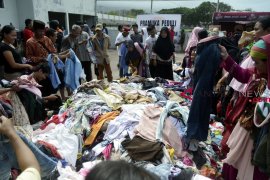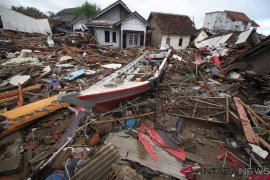The idea dates back to the time under the administration of the countrys first President Soekarno. A serious plan inspired by the idea was made under President Suharto.
Last year, Public Works Minister Djoko Kirmanto said the ministry was in the final phase of drafting a cooperation agreement between the government a consortium to build the project.
Earlier planning consultant Wiratman & Association estimated the project, which includes development of areas in both ends of the bridge will cost US$25 billion .
Construction of the 30-kilometer bridge will cost US$10 billion and development of the areas in both end of the bridge will cost around US$15 billion.
The government said construction of the project will take around 10 years.
The Sunda Strait bridge (JSS) as it is called, would be greatly facilitate transport between the countrys most populous islands contributing to the countrys economic development.
Deputy chairman of the Batam branch of the influential Indonesian Chamber of Commerce and Industry (Kadin) Deden Syaiful Achyar the JSS described the project is urgent.
"Rapid economic growth in Java needs support from adequate transport facility and development of the JSS project is a solution," Deden said earlier this week.
The JSS would solve problem in ferry transport such as frequent long queue of cargo trucks and passenger cars in taking their turn to be ferried across Sunda strait, he said.
The JSS would not put an end to ferry service between Merak and Bakauheni, he said, adding ferry transport will still be needed.
He said based on data from the Central Bureau of Statistic (BPS), Java and Sumatra accounted for 78 percent of the countrys GDP in 2010. Therefore, inadequate infrastructure still a problem in both Java and Sumatra.
He said 1.5 to 2.5 hours are need to cover the 63 kilometer distance between Merak and Bakauheni by ferry, and as ferry carries not more than 1,000 passengers, 120 cars, and 20 heavy trucks.
"JSS would be much more efficient and transport would not be hampered by bad weather or big waves, when one is sailing in the sea," he said.
In addition, transport would be much faster and distribution of goods would be more efficient in Java and Sumatra.
However, as said by the director of PT Graha Banten Lampung Sejahtera (GBLS) Winarjono said so far there has been no sign the project would be finally implemented.
GBLS is a consortium to develop supporting zones or growth areas in both end of the more than 30 kilometer bridge in Lampung and Banten.
The government has not decided who is to carry out the feasibility study (FS) for the project of supporting zones.
"So far there has been no guidelines from the government to the consortium. PT GBLS is still awaiting guidelines from the government whether the project is to be implemented or not," Winarjono said.
He said the groundbreaking could not be expected in 2014, adding it would be postponed until no sooner than mid 2015.
He said the consortium would continue to encourage realization of the project . Currently PT GBLS is seeking cooperation with local and foreign partners such as with leading universities in Indonesia in studying the mega project .
Coordinating Minister for Economy Hatta Rajasa has said the feasibility study (for the construction of the JSS is to be wrapped up in 2014.
"Currently the project is being discussed . Its feasibility study is expected to be completed in 2014," Hatta said when visiting Pandeglang, Banten, recently.
A Team of Seven has given recommendations with a number of options of whether the project is to be awarded to a consortium of a number of companies or to state companies or it is to be handled by the government itself, he said.
"One thing is certain that the government could not possibly use fund from state budget to build the project. Therefore, the likeliest option is to hand it over to the project initiators to team up with state companies," he said.
He said large budget would be needed for feasibility study alone reaching around Rp1.2 trillion and construction of the bridge would cost around Rp200 trillion .
He said the project would need a big money and yet it is to be implemented as it is more than just building a bridge across the strait.
The bridge project would help boost the growth of strategic economic areaa, he said.
JSS, he said, would at least contribute to expansion of eight to nine economic zones in Banten and Sumatra, such as tourism special economic zone of KEK) of Pandeglang, Banten.
In order to boost economic development in Sumatra and Banten , the government already has program to build three toll roads in Sumatra including in Lampung, South Sumatra and Dumai.
"Funds for the three toll road projects would reach around Rp5 trillion and Rp2 trillion of which would be disbursed this year and the rest in 2014," he said.
The project is feasible based on a number of initial feasibility studies already held.
"Studies on the JSS was already made at the time of President Bung Karno , and it is indeed, feasible," Hatta said, adding," our duty is to implement it."
Supporting Zones
The regional administration of the provinces of Lampung and Banten and the consortium of PT Graha Banten Lampung Sejahtera (GBLS) have worked out plan toward implementation of the JSS project by studying development of supporting zones.
Banten Governor Ratu Atut Chosiyah said recently that the provincial administration and the consortium of PT GBLS had studied development of supporting zone as a growth areas in Banten while awaiting a decision from the central government.
"Whatever we will do to start the JSS project would not go beyond the authority of the regional administration.
"We will only prepare development of the growth area related to the JSS project," Ratu Atut said.
She said the feasibility study would determine the growth area in Banten, adding , Lampung is also doing the same.
She said the growth areas would also include the industrial city of Cilegon , the regencies of Serang , Pandeglang and Lebak.
The areas of the growth center to be developed are outside protected forests and areas safe from floods.
(H-ASG/A014)
Reporter: Sambas/Alberth Saragih
Editor: Jafar M Sidik
Copyright © ANTARA 2013












